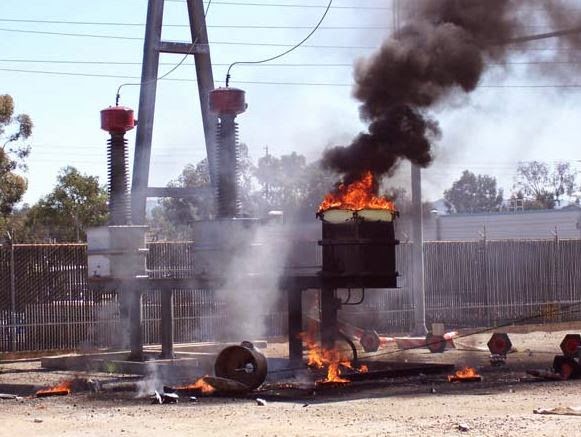MARCH 24, 2015
AUSTIN, TEXAS
One person suffered minor burns after an electrical
transformer exploded on the 34th floor of a high-rise building downtown,
according to the Austin Fire Department.
The explosion occurred at The Bowie, a downtown apartment
complex at 311 Bowie Street between West Third Street and West Fifth Street
near Shoal Creek.
The person injured was taken to University Medical Center
Brackenridge with minor burns.
According to AFD spokesperson Palmer Buck, the fire was
caused by an electrical short and the damage was confined to the electrical
room.
The fire is out, but crews are still on the scene removing
smoke and most of the building is without power. Fifth Street was closed
briefly but has since reopened.
Source: http://www.kvue.com
//----------------------------//
//----------------------------//
HOW DO UNDERGROUND AND ABOVE-GROUND ELECTRIC TRANSFORMERS EXPLODE
Electrical transformers transfer energy between circuits,
switching energy from one voltage to another. But when flooded with too much
electricity, the sudden surge can cause a transformer explosion. As
transformers detect an energy spike, they're programmed to turn off, but it can
take up to 60 milliseconds for the shutdown. However fast those milliseconds
may seem, they still may be too slow to stop the electrical overload.
A chamber full of several gallons of mineral oil keeps the
circuits cool, but given too much electricity, the circuits fry and melt,
failing in a shower of sparks and setting the mineral oil aflame. Mineral oil,
in turn, combusts explosively and rockets transformer scything into the air.
All it takes is a trigger, a corroded or faulty wire, and
the circuits surge will get ahead of the breaker--and in New York City, the
previous day's snowstorm could have done the trick. Underground electric
systems often suffer problems after heavy snowfall, says Bob McGee, a
spokesperson for Con Ed. While salting streets may make vehicles and
pedestrians safer, the salt can create hazardous conditions for underground
electrical systems--salt that slips through manholes can corrode wires.
If any arcing
failure occurs within an oil-impregnated-paper (OIP) bushing, it frequently
results in an explosive failure, causing arcing in the air, an oil spill and a
major oil fire. This is not the case with resin-impregnated polymer insulator
bushings.
Manhattan houses 35,000 underground and 47,000 overhead
transformers for its 10 million residents, and of those 82,000, about 35 fail
every year, McGee says. A failure doesn't always equate to a fire or explosion
either; in fact, in the steadily decreasing number of failures per year, such
an explosion is rare.
Cable terminations
failures in air- or oil-filled cable boxes also result in a high percentage of
transformer fires. The typical scenario with oil-filled cable boxes is the
initiation of an arcing fault in or at the cable termination. The pressure
buildup from the arc ruptures the cable box explosively, ignites oil in or from
the cable box, which continues and escalates as it gets fueled by oil spilling
from the conservator or the main tank.
Mechanical forces on
the cables from the explosive pressure forces and the fault current will often
cause breakage of the bushings, and the oil spilling from the broken bushings
will then be ignited by the arc.
Though the snowstorm may have had something to do with the
incident, it will take time to analyze just what went wrong. If it turns out
the salt from the snowstorm wasn't to blame, it may have been an older
transformer. These can explode when their insulating materials begin to fail.
This happens as cellulose and oil absorb water over time and degrade
cellulose's ability to insulate, triggering an explosion.
The U.S. expanded its electrical infrastructure in the 1950s
and '60s, and now, most older transformers have met or are nearing the end of
their operational lives of between thirty to forty years.


